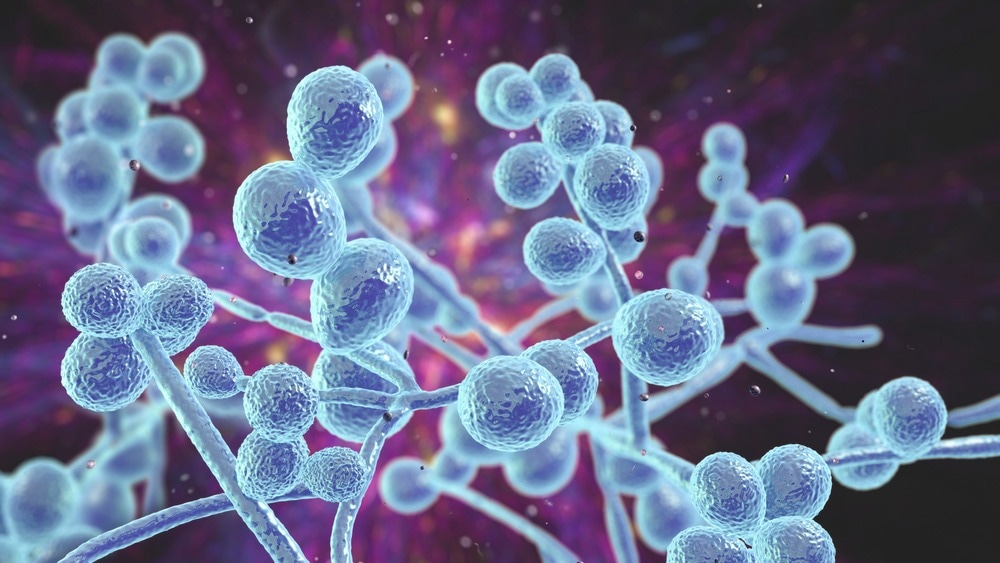In a recent study posted to the medRxiv* preprint server, researchers evaluated the concurrent colonization of fungi in the nasopharynx of severe coronavirus disease 2019 (COVID-19) patients. They explored antifungal immunity pathways by analyzing data from their previous study comprising patients with acute SARS-CoV-2 (severe acute respiratory syndrome coronavirus 2) infections.
 Study: Severe COVID-19 is associated with fungal colonization of the nasopharynx and potent induction of IL-17 responses in the nasal epithelium. Image Credit: Kateryna Kon/Shutterstock
Study: Severe COVID-19 is associated with fungal colonization of the nasopharynx and potent induction of IL-17 responses in the nasal epithelium. Image Credit: Kateryna Kon/Shutterstock

 *Important notice: medRxiv publishes preliminary scientific reports that are not peer-reviewed and, therefore, should not be regarded as conclusive, guide clinical practice/health-related behavior, or treated as established information.
*Important notice: medRxiv publishes preliminary scientific reports that are not peer-reviewed and, therefore, should not be regarded as conclusive, guide clinical practice/health-related behavior, or treated as established information.
Background
Studies have reported fungal infections as severe COVID-19 infection complications; however, the fungal colonization frequency and their association with immunological responses among SARS-CoV-2-positive patients have not been well-characterized and warrant further investigation.
The authors of the present study previously performed single-cell ribonucleic acid-sequencing (scRNA-seq) analysis to characterize the upper respiratory tract (URT) microenvironment in SARS-CoV-2 infections and showed profoundly lowered interferon (IFN) type I and III levels in the URT, in a directly proportional relationship with COVID-19 severity. The samples were classified based on meta-transcriptomic taxonomical classification and the reference NCBI (national center for biotechnology information) database.
About the study
In the present cross-sectional study, researchers characterized the clinical characteristics of 56 (out of 58) previous study participants and identified those with severe SARS-CoV-2 infections and concomitant Candida species-derived transcript detection within URT [tracheal and nasopharyngeal (NP)] samples.
The study comprised 15, 35, and six healthy individuals, acute COVID-19 patients, and SARS-CoV-2-negative intubated patients, respectively. NP swab specimens obtained from the participants were subjected to scRNA-seq analysis to determine the cellular composition of the nasal epithelium. COVID-19 patient samples were obtained within nine days of hospitalization, estimated to be within 14 days of the initial respiratory symptoms.
In addition to the previous study data, data of matched ETA (endotracheal aspirates obtained from four severe COVID-19 patients were analyzed. Almost all Candida-positive ETA or NP samples were obtained within seven days of hospitalization. Most (six out of eight) were intubated for ≥1.0 days, of which five had received corticosteroids for ≥1.0 days before sample collection.
Patients were clinically evaluated for fungal infections among three COVID-19 patients with high Candida spp. abundance, as identified previously by meta-transcriptomics. Further, the team investigated whether the nasal tissues of such individuals showed reactive or aberrant or reactive IL-17 expression. The expression of interleukins (IL)- 1β, 4, and 17A, and IFN-α, g genes was evaluated. Nasal epithelial cells were examined for transcriptomic signatures consistent with the cytokine levels.
Results
Severe COVID-19 patients consistently expressed greater IL-17A-induced gene expression and serological 1,3-β-D-glucan levels (prompting micafungin antifungal treatment) compared to mild or moderate COVID-19 patients and healthy individuals. Significant expression of antifungal inflammatory cascades was observed in URT epithelial tissues of severe SARS-CoV-2 infection patients, even among those lacking detectable genomic material from fungal pathogenic organisms.
Candida albicans was the second most abundant (six NP samples) microbe after SARS-CoV-2 in the study cohort. In addition, elevated Candida dubliniensis and Candida glabrata expression were observed in four and two NP samples of severe COVID-19 patients, respectively. In addition, C. albicans was detected in almost all (except one) ETA samples of individuals with severe SARS-CoV-2 infections, and all C. albicans-positive ETA samples showed C. dubliniensis positivity.
Candida spp. reads were only detected among severe COVID-19 patients with mechanical ventilation and intubation requirements. RNA-seq results correlated generally with those of ETA aspirates. The findings indicated a significant clinical concern for hospitalized severe COVID-19 patients for Candida infection testing. 28-day death rates among COVID-19 patients were comparable between Candida spp. positive vs. negative individuals.
Almost all Candida-positive COVID-19 patients had a T2DM (type II diabetes mellitus) history, and eight patients were hypertensive. Across participants, IL-17A gene exposure enhanced the expression of genes involved in keratinization [small proline-rich protein (SPRR)-2G, 2E and 2F], neutrophil, lymphocytes, and monocyte chemoattraction [chemokine (C-C motif) ligand 20 (CCL-20), C-X-C motif chemokine ligand (CXCL)-1, 2, and 3], and inflammatory S100(calcium-binding protein)-A7, A8 factors.
IL-17A-induced genes [SAA-1 (serum amyloid A1), SAA-2, SAT-1 (spermidine/spermine N1-acetyltransferase 1, LCN-2 (lipocalin 2), GLUL (glutamate-ammonia ligase) and S100A8] were upregulated significantly among nasal epithelial cells of severe SARS-CoV-2 infection patients. Of interest, the team did not observe a greater abundance of IL-17A genes module among severe SARS-CoV-2 infection patients with Candida species than those without the fungal organisms.
Likewise, there were no significant differences observed in IFN-induced genes between participants with the presence and absence of detectable Candida species. Participants with elevated IFNα-induced gene abundance in the nasal epithelium did not show IL17A-induced gene upregulation. The findings showed that IL-17A-stimulated gene induction in nasal mucosa denoted a feature shared among severe SARS-CoV-2 infection patients and showed a correlation with the lack of robust IFN-induced antiviral immune responses.
Overall, the study findings showed IL-17 stimulation was partially driven by Candida species colonization and blunted type I/III IFN signaling as a common feature of severe SARS-CoV-2 infections.

 *Important notice: medRxiv publishes preliminary scientific reports that are not peer-reviewed and, therefore, should not be regarded as conclusive, guide clinical practice/health-related behavior, or treated as established information.
*Important notice: medRxiv publishes preliminary scientific reports that are not peer-reviewed and, therefore, should not be regarded as conclusive, guide clinical practice/health-related behavior, or treated as established information.